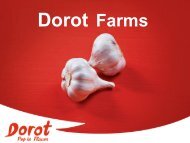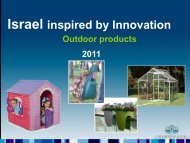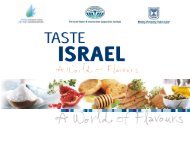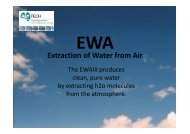PDF file - Israel Trade Commission
PDF file - Israel Trade Commission
PDF file - Israel Trade Commission
You also want an ePaper? Increase the reach of your titles
YUMPU automatically turns print PDFs into web optimized ePapers that Google loves.
Agriculture 2011<br />
Sea Transport of Easter<br />
Lily* cut Flowers:<br />
Determination of the<br />
Optimal Harvest Stage<br />
Shimon Meir 1* , Shoshana<br />
Salim 1* , Betina Kochanek 1* ,<br />
Tamar Tzadka 1* , Tamar Lahav 2*<br />
and Sonia Philosoph-Hadas 1*<br />
Figure 1: Definition of the opening and senescence stages of the<br />
lily florets cv. ‘White Heaven’ from stage 1 = closed, green floret of<br />
7-9 cm length, through stage 8 = the senescence stage, in which<br />
the petals turn transparent, wilted and tend to drop. Stage 5 was<br />
defined as the opening stage, while stage 6 represents full opening.<br />
The transition from stage 5 to 6 lasts only few hours.<br />
Introduction<br />
Easter lily (Lilium Longiflorum) cut flowers are quite large<br />
and heavy. Therefore, it is most important to reduce<br />
their shipping costs by exporting them via sea freight<br />
rather than by air transport. According to financial<br />
analyses, sea transport in comparison to air transport<br />
(marketing and freight) amounted to a savings of 17,000<br />
IS per dunam, which is very significant for the growers.<br />
As such, reliable methods for shipping lilies by sea<br />
transport should be developed.<br />
Flower auctions and dealers generally receive the lily<br />
*(Lilium Longiflorum)<br />
10<br />
cut flowers before their florets start to open, when the<br />
first floret reaches its maximum closed bud size. This<br />
stage is also the recommended harvest stage when the<br />
flowers are transported by air. The recommendations<br />
for postharvest treatment developed in our laboratory<br />
included pulsing with preservatives containing<br />
8-hydroxyquinoline citrate and surfactants (TOG-4,<br />
Merhav Agro Ltd., Ashdod, <strong>Israel</strong>), together with the<br />
gibberellin GA 3 at a concentration of 25 ppm to delay<br />
leaf senescence and yellowing. We have shown that<br />
the GA 3 pulsing treatment was very effective also in<br />
delaying leaf and flower senescence of various other lily<br />
cultivars, such as Longiflorum x Asiatic hybrid ‘Shira’<br />
and Lilium candidum L.<br />
The present study describes the development of sea<br />
transport conditions for shipping Easter lily cut flowers<br />
cvs. ‘White Heaven’ and ‘Maggie Blanche’ bearing two<br />
or multiple florets per stem, as compared to their air<br />
transport. The study was focused on determination of<br />
the optimal harvest stage for the sea shipment.<br />
Materials and Methods<br />
Chemicals: TOG-6 containing organic chlorine, TOG-4<br />
containing 8-hydroxyquinoline citrate, the ‘Teabag’<br />
formulation containing the gibberellin GA 3 (all supplied<br />
by Merhav Agro Ltd., Ashdod, <strong>Israel</strong>).<br />
Pulsing treatments and shipment simulations: Lily<br />
flowers were harvested from the growers at various<br />
harvest stages (as detailed in Figures 1-4), sorted and<br />
bound into 5-stem bunches, and then brought in cartons<br />
to the laboratory at the Volcani Center. Immediately upon<br />
their arrival, the flowering stems were pulsed for 4 h at<br />
20°C and additional 16 h at 2°C with the recommended
















